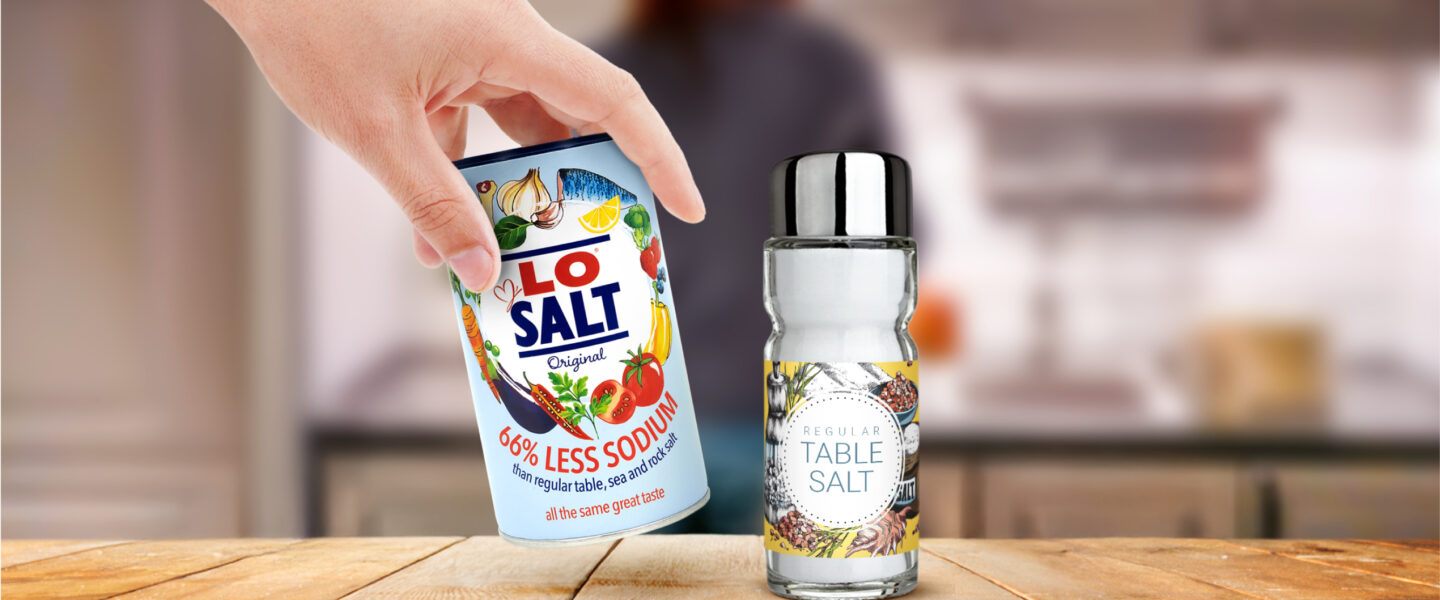16 June 2025

The Salt Switch:
One Simple Change for Better Health
New research reveals over 40% of Brits still automatically reach for the saltshaker – despite the health risks. While we may be more health conscious, habits aren’t shifting fast enough, keeping us at risk of heart disease and stroke.
Excess sodium intake – mainly from salt – remains the most significant yet modifiable dietary risk factor for death globally. In the UK, if everyone cut just 1g of salt a day, we could prevent over 4,000 premature deaths each year. But we’re still consuming 40% more than the recommended 6g/day.
A new survey commissioned by LoSalt®, supported by leading health experts, found only a quarter of Brits would stop using salt unless they fell seriously ill. One in three of us salt food without tasting it, and 66% use salt while cooking.
A ‘new’ solution to an old problem
Cutting salt has long been public health advice, but it’s a tough habit to break. Four in five people say they add salt for flavour, and 42% do it out of habit.
This January, the World Health Organisation advised consumers to “opt instead for a potassium-enriched, lower-sodium salt” when using table salt.
Dr. Sarah Jarvis, GP and medical broadcaster, explains: “The health case for reducing sodium is clear, but what many people don’t realise is that there are clear health benefits for increasing the potassium in your diet, most notable being the lowering blood pressure. Actively cutting down on regular salt and replacing it with a lower-sodium, potassium-enriched salt – such as LoSalt® – has been shown to reduce the risk of heart attacks and stroke. With 41% of people saying they’d switch on a doctor’s recommendation; it’s time for the healthcare professionals to be more proactive about this simple but effective intervention”.
Nutritionist Azmina Govindji adds: “What’s fascinating is that we’ve had this simple solution all along – it’s not new technology or a radical innovation. We need to make consumers aware that switching their regularly purchased table salt to a reduced sodium alternative doesn’t mean they need to compromise on taste.
“I like the idea of switching the salt in your saltshaker. Behaviour change needs to be practical and realistic and this simple switch can make a significant difference to your sodium intake over time. No complex label-reading or massive lifestyle change. Worryingly 48% of Brits have no idea how much salt they consume, so potassium-enriched alternatives provide a practical solution that works with existing habits – seamlessly.”
Everyday Salt Traps and How to Avoid Them
The research identified several common “salt traps” that many of us fall into:
- The Automatic Sprinkle: 1 in 3 Brits admit to adding salt to food before even tasting it, with young Brits being the worst offenders. Try adopting a “taste first” policy at home.
- The Takeaway Top-Up: Almost 1 in 3 Brits add extra salt to their takeaways, with fish and chips topping the list (28%) and 1 in 6 people adding salt to this already sodium-rich meal, both at home and at the chip shop. Next time, try a squeeze of lemon instead.
- The Recipe Rebellion: 4 in 5 Brits don’t precisely measure their salt when cooking (adding salt by eye or instinct), with nearly half adding more than just a pinch. Consider halving the salt in recipes and using a low-sodium alternative.
- The Table Habit: 3 in 4 Brits still put salt on the dining table at meal times. Try replacing it with herbs, spices, or a reduced-sodium alternative.
- The Hidden Salt: Nearly half of Brits (48%) admit they have no idea how much salt they consume, and a staggering 94% don’t know the correct daily salt limit. Learning to spot high-salt products can make a big difference.
The Simple Switch That Makes a Big Difference
Dietitian Nichola Ludlam-Raine says: “What’s truly innovative about potassium-enriched salt alternatives is that they flip traditional public health messaging on its head. Instead of telling people what not to do, this approach meets people where they are. With 4 in 10 Brits admitting they salt their food out of habit, and 66% adding salt while cooking, we need practical solutions that work in real kitchens, not just in nutrition textbooks. This is a refreshingly novel approach to public health that focuses on smarter swaps rather than deprivation.
“People often think reducing salt means sacrificing flavour, but that’s not the case,” Ludlam-Raine notes. “I always recommend people taste first, before seasoning further, for those who do need that extra bit of flavour, products like LoSalt give you the same savoury taste but with significantly less sodium. You use it exactly the same way as regular salt – in cooking, baking, or at the table.”
Making the Change Easier
For those looking to reduce their salt intake, the survey found that many people would be encouraged to switch if:
- They had clear information about the health benefits (50% of respondents)
- Their doctor recommended it (41% of respondents)
- They could find low-sodium alternatives more easily in supermarkets (26% of respondents)
- They could try samples first to ensure they liked the taste (25% of respondents)
“What’s encouraging is that when people understand the benefits and try alternatives like LoSalt, they typically find it’s an easy change to make,” says Ludlam-Raine. “Unlike many health-focused changes that require significant adjustment, this one is remarkably simple – same taste, same use, just less sodium.”
